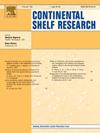Observations and generation of internal waves in the Strait of Sicily
IF 2.1
3区 地球科学
Q2 OCEANOGRAPHY
引用次数: 0
Abstract
Oceanic internal solitary waves (ISWs) can be generated by several mechanisms, among which by tidal flow over shallow bathymetry, atmospheric forcing, unbalanced sub-mesoscale flow without external forcing and rapid displacements of the sharp fronts separating e.g. cold ocean water masses or river plumes from the ambient seawater. In this paper, we analyze synthetic aperture radar (SAR) images acquired by the Sentinel-1 satellites over the Adventure Bank area, located on the western side of the Strait of Sicily in the years 2018–2021 showing numerous radar signatures of ISWs. This is the first time that massive presence of ISWs is reported in this area of the Mediterranean Sea. The internal wave field, observed primarily in the months from May to September, is very heterogeneous, with wavelengths ranging from a few hundred meters to a few kilometers, wave front lengths from a few km to about 40 km, and propagating in almost any direction. This suggests that the internal waves detected in the SAR images are generated by a variety of mechanisms and not by a specific one. Although in general tidal currents are weak in the Mediterranean Sea, the sum of the tidal flow and the Atlantic-Ionian Stream current can attain values up to 0.3 m s−1 such that ISW generation by interaction with shallow underwater bottom topography becomes possible. Furthermore, cold filaments and sub-mesoscale cyclonic eddies generated by upwelling at the south coast of Sicily, feature sharp and rapidly moving fronts, from which ISWs may originate. Theoretical evidence for these two types of ISW generation mechanisms is provided by model results obtained from the 1/48° resolution ENEA model and the 100 m resolution Delft3D model.
西西里海峡内波的观测与生成
海洋内孤波(ISWs)可由多种机制产生,其中包括浅水深潮汐流、大气强迫、无外部强迫的不平衡次中尺度流以及将冷水团或河流羽流等从环境海水中分离出来的锋面的快速位移。在本文中,我们分析了 Sentinel-1 号卫星在 2018-2021 年期间在位于西西里海峡西侧的冒险滩地区获取的合成孔径雷达(SAR)图像,这些图像显示了大量 ISW 的雷达特征。这是首次报道在地中海的这一区域存在大规模的 ISWs。主要在 5 月至 9 月观测到的内波场非常不均匀,波长从几百米到几千米不等,波前长度从几千米到约 40 千米不等,传播方向几乎不限。这表明合成孔径雷达图像中探测到的内波是由多种机制而非特定机制产生的。虽然地中海的潮汐流一般较弱,但潮汐流和大西洋-爱奥尼亚海流的总和可达到 0.3 米/秒-1,因此通过与水下浅层地形相互作用产生内波是可能的。此外,西西里岛南岸上升流产生的冷丝和亚中尺度气旋漩涡具有锋利和快速移动的特点,ISW 可能就源于此。1/48° 分辨率的 ENEA 模型和 100 米分辨率的 Delft3D 模型得出的结果为这两种 ISW 生成机制提供了理论证据。
本文章由计算机程序翻译,如有差异,请以英文原文为准。
求助全文
约1分钟内获得全文
求助全文
来源期刊

Continental Shelf Research
地学-海洋学
CiteScore
4.30
自引率
4.30%
发文量
136
审稿时长
6.1 months
期刊介绍:
Continental Shelf Research publishes articles dealing with the biological, chemical, geological and physical oceanography of the shallow marine environment, from coastal and estuarine waters out to the shelf break. The continental shelf is a critical environment within the land-ocean continuum, and many processes, functions and problems in the continental shelf are driven by terrestrial inputs transported through the rivers and estuaries to the coastal and continental shelf areas. Manuscripts that deal with these topics must make a clear link to the continental shelf. Examples of research areas include:
Physical sedimentology and geomorphology
Geochemistry of the coastal ocean (inorganic and organic)
Marine environment and anthropogenic effects
Interaction of physical dynamics with natural and manmade shoreline features
Benthic, phytoplankton and zooplankton ecology
Coastal water and sediment quality, and ecosystem health
Benthic-pelagic coupling (physical and biogeochemical)
Interactions between physical dynamics (waves, currents, mixing, etc.) and biogeochemical cycles
Estuarine, coastal and shelf sea modelling and process studies.
 求助内容:
求助内容: 应助结果提醒方式:
应助结果提醒方式:


